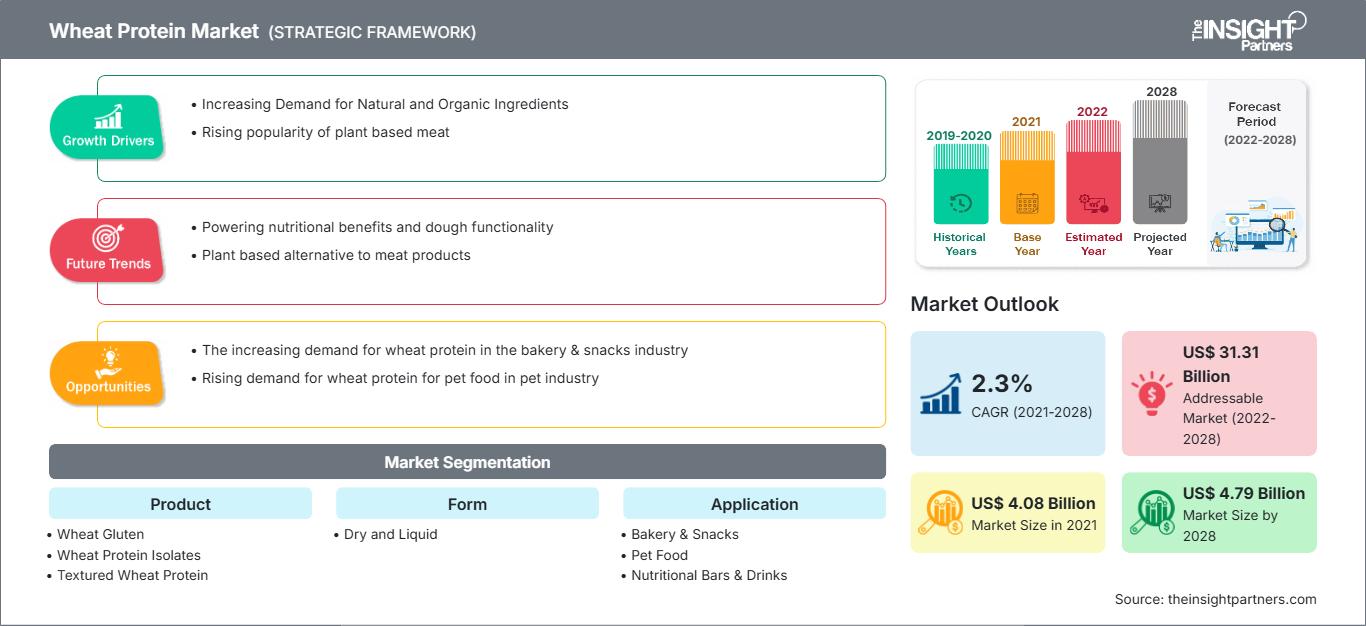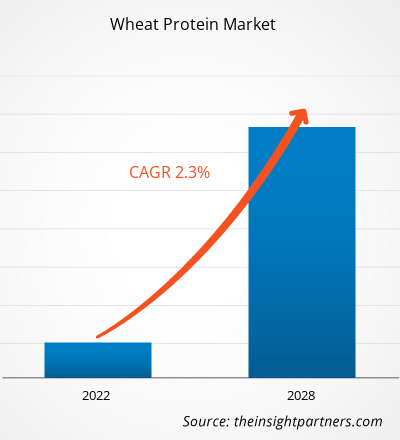[Informe de investigación] El mercado de proteína de trigo se valoró en US$ 4.083,05 millones en 2021 y se proyecta que alcance los US$ 4.788,49 millones para 2028; se espera que crezca a una CAGR del 2,3% de 2021 a 2028.
Las proteínas de trigo son proteínas vegetales que se obtienen principalmente mediante el procesamiento del trigo con diferentes enzimas. Son proteínas funcionales insolubles que poseen características viscoelásticas únicas y ofrecen elasticidad y extensibilidad al producto final. Se consideran una alternativa viable a las proteínas animales. Se utilizan ampliamente en diversas industrias, como panadería y confitería, cosmética y cuidado personal, alimentación animal y suplementos nutricionales.
En 2020, Europa representó la mayor participación en los ingresos del mercado mundial de proteína de trigo. El mercado europeo está segmentado en Alemania, Francia, Italia, Reino Unido, Rusia y el resto de Europa. La creciente concienciación sobre la salud entre los consumidores impulsa la demanda de numerosos productos de proteína vegetal, como la soja, el trigo y la avena. La popularidad de la proteína de trigo ha aumentado en toda la región, especialmente en Alemania, Francia y el Reino Unido. Los europeos están adoptando cada vez más la dieta flexitariana, es decir, sustituyendo parte o la mayor parte de su consumo de carne por alimentos proteicos alternativos. Estos factores impulsan la demanda de productos de proteína de trigo en Europa.
Recibirá personalización de cualquier informe, sin cargo, incluidas partes de este informe o análisis a nivel de país, paquete de datos de Excel, y además aprovechará grandes ofertas y descuentos para empresas emergentes y universidades.
Mercado de proteína de trigo: Perspectivas estratégicas

-
Obtenga las principales tendencias clave del mercado de este informe.Esta muestra GRATUITA incluirá análisis de datos, desde tendencias del mercado hasta estimaciones y pronósticos.
Muchas industrias, como la de alimentos y bebidas, se enfrentaron a desafíos sin precedentes debido a la pandemia de COVID-19. Debido a la escasez de materia prima, el cierre de fábricas, la escasez de mano de obra y otras dificultades para operar bajo los protocolos de seguridad de la COVID-19, las empresas dedicadas a la fabricación de proteína de trigo enfrentaron dificultades durante los primeros meses de la pandemia. El sector de alimentos y bebidas es el mayor consumidor de proteína de trigo, y la pandemia de COVID-19 en curso ha afectado negativamente a la demanda de proteína de trigo. Los productos alimenticios y bebidas, como productos de panadería, confitería y lácteos, se están retrasando, ya que los supermercados han reasignado sus prioridades de inventario hacia productos básicos y suministros esenciales debido al brote. Sin embargo, a medida que las economías reactivan sus operaciones, se prevé que la demanda de proteína de trigo aumente a nivel mundial en los próximos meses. La pandemia de COVID-19 ha generado una mayor demanda de productos de panadería saludables y funcionales, lo que se espera que impulse el crecimiento del mercado de proteína de trigo en los próximos años.
Perspectivas del mercado
Creciente demanda de ingredientes naturales y orgánicos
La importancia de los alimentos orgánicos se ha comprendido a raíz de los alarmantes problemas de salud, junto con la creciente conciencia sobre las certificaciones orgánicas y la creciente preferencia por alimentos de alta calidad. Hoy en día, los consumidores buscan ingredientes naturales, limpios y sencillos con etiquetas adecuadas que reflejen eficazmente su contenido, calidad y propósito del producto. Además, dependen en gran medida de productos alimenticios orgánicos y naturales. Por ejemplo, el consumo de proteína de trigo orgánica ha experimentado un aumento considerable en diversos sectores, como alimentos y bebidas, y alimentos para animales y peces. Por ello, los fabricantes de proteína de trigo se están centrando en el desarrollo y la comercialización de proteína de trigo orgánica.
Información sobre el producto
Según el producto, el mercado global de proteína de trigo se segmenta en gluten de trigo, aislados de proteína de trigo, proteína de trigo texturizada y proteína de trigo hidrolizada. En 2020, el segmento de gluten de trigo representó la mayor participación en los ingresos. El gluten de trigo vital se utiliza como aditivo en panadería. Aporta elasticidad a harinas que, de otro modo, serían bajas en gluten, como la harina integral o la de centeno. El gluten de trigo también mejora la leudación de la masa cruda y mejora la textura y la masticabilidad del producto final.
Información sobre formularios
El mercado de la proteína de trigo, por su presentación, se divide en seco y líquido. En 2020, el segmento seco representó una mayor participación en los ingresos. Algunas de las propiedades de la proteína de trigo seca son su alta solubilidad en agua a cualquier valor de pH, capacidad de fijación de agua y emulsionante, baja viscosidad y estabilidad ácida y térmica. La proteína de trigo seca se utiliza cada vez más en panaderías, alimentos para mascotas, barras nutricionales, carne procesada y análogos de carne. Por lo tanto, su amplia aplicación en la industria alimentaria está impulsando el crecimiento del mercado del segmento seco.
Perspectivas de la aplicación
El mercado de la proteína de trigo, por aplicación, se segmenta en panadería y snacks, alimento para mascotas, barras y bebidas nutricionales, carne procesada, análogos de carne, entre otros. En 2020, el segmento de panadería y snacks representó la mayor participación en los ingresos. Numerosos productos de panadería, como panecillos, pan, galletas, pasteles, tartas y muffins, son populares entre los consumidores. Las proteínas de trigo se encuentran entre los ingredientes comunes que optimizan el comportamiento de la masa y mejoran las propiedades nutricionales de los productos finales. La creciente demanda de proteína de trigo en la industria de panadería y snacks y la tendencia de las etiquetas limpias están creando amplias oportunidades para los actores que operan en el mercado de la proteína de trigo a nivel mundial.
Archer Daniels Midland Company; Roquette Frères; Glico Nutrition Co., Ltd; Kröner-Stärke GmbH; Cargill, Incorporated; Crespel & Deiters GmbH & Co. KG; CropEnergies AG; Manildra Group; MGP Ingredients Inc.; y Tereos Group son algunos actores consolidados en el mercado global de proteína de trigo. Las empresas del mercado están adoptando diversas estrategias, como desarrollos de productos, expansiones de plantas y fusiones y adquisiciones, para expandir su presencia global y satisfacer la creciente demanda de los usuarios finales. Por ejemplo, en 2020, Archer Daniels Midland Company desarrolló nuevos productos. Los productos contienen proteínas de guisante texturizadas Arcon T, proteína de trigo texturizada Prolite MeatTEX y proteína de trigo no texturizada Prolite MeatXT.
Informe destacado
- Tendencias progresivas de la industria en el mercado global de proteína de trigo para ayudar a los actores a desarrollar estrategias efectivas a largo plazo.
- Estrategias de crecimiento empresarial adoptadas por los mercados desarrollados y en desarrollo
- Análisis cuantitativo del mercado mundial de proteína de trigo de 2019 a 2028
- Estimación de la demanda de proteína de trigo en diversas industrias
- Desarrollos recientes para comprender el escenario competitivo del mercado y la demanda de proteína de trigo
- Tendencias y perspectivas del mercado junto con los factores que impulsan y restringen el crecimiento del mercado de proteína de trigo
- Proceso de toma de decisiones mediante la comprensión de las estrategias que sustentan el interés comercial con respecto al crecimiento del mercado mundial de proteína de trigo
- Tamaño del mercado de proteína de trigo en varios nodos del mercado
- Descripción detallada y segmentación del mercado mundial de proteína de trigo, así como su dinámica en la industria.
- Tamaño del mercado de proteína de trigo en varias regiones con prometedoras oportunidades de crecimiento
Perspectivas regionales del mercado de proteína de trigo
Los analistas de The Insight Partners han explicado detalladamente las tendencias regionales y los factores que influyen en el mercado de proteína de trigo durante el período de pronóstico. Esta sección también analiza los segmentos y la geografía del mercado de proteína de trigo en América del Norte, Europa, Asia Pacífico, Oriente Medio y África, y América del Sur y Central.
Alcance del informe de mercado de proteína de trigo
| Atributo del informe | Detalles |
|---|---|
| Tamaño del mercado en 2021 | US$ 4.08 mil millones |
| Tamaño del mercado en 2028 | 4.790 millones de dólares estadounidenses |
| CAGR global (2021-2028) | 2,3% |
| Datos históricos | 2019-2020 |
| Período de pronóstico | 2022-2028 |
| Segmentos cubiertos |
Por producto
|
| Regiones y países cubiertos |
América del norte
|
| Líderes del mercado y perfiles de empresas clave |
|
Densidad de actores del mercado de proteína de trigo: comprensión de su impacto en la dinámica empresarial
El mercado de la proteína de trigo está creciendo rápidamente, impulsado por la creciente demanda del consumidor final debido a factores como la evolución de las preferencias de los consumidores, los avances tecnológicos y un mayor conocimiento de los beneficios del producto. A medida que aumenta la demanda, las empresas amplían su oferta, innovan para satisfacer las necesidades de los consumidores y aprovechan las tendencias emergentes, lo que impulsa aún más el crecimiento del mercado.

- Obtenga una descripción general de los principales actores clave del mercado de proteína de trigo
Mercado de proteína de trigo, por
- Producto
- Gluten de trigo
- Aislados de proteína de trigo
- Proteína de trigo texturizada
- Proteína de trigo hidrolizada
Mercado de proteína de trigo, por forma
- Seco
- Líquido
Mercado de proteína de trigo, por aplicación
- Panadería y Snacks
- Comida para mascotas
- Barras y bebidas nutricionales
- Carne procesada
- Análogos de la carne
- Otros
Perfiles de empresas
- Compañía Archer Daniels Midland
- Roquette Frères
- Glico Nutrition Co., Ltd.
- Kröner-Stärke GmbH
- Cargill, Incorporated
- Crespel & Deiters GmbH & Co. KG
- CropEnergies AG
- Grupo Manildra
- Ingredientes MGP Inc.
- Grupo Tereos
- Análisis histórico (2 años), año base, pronóstico (7 años) con CAGR
- Análisis PEST y FODA
- Tamaño del mercado, valor/volumen: global, regional y nacional
- Industria y panorama competitivo
- Conjunto de datos de Excel
Informes recientes
Testimonios
Razón para comprar
- Toma de decisiones informada
- Comprensión de la dinámica del mercado
- Análisis competitivo
- Información sobre clientes
- Pronósticos del mercado
- Mitigación de riesgos
- Planificación estratégica
- Justificación de la inversión
- Identificación de mercados emergentes
- Mejora de las estrategias de marketing
- Impulso de la eficiencia operativa
- Alineación con las tendencias regulatorias






















 Obtenga una muestra gratuita para - Mercado de proteína de trigo
Obtenga una muestra gratuita para - Mercado de proteína de trigo